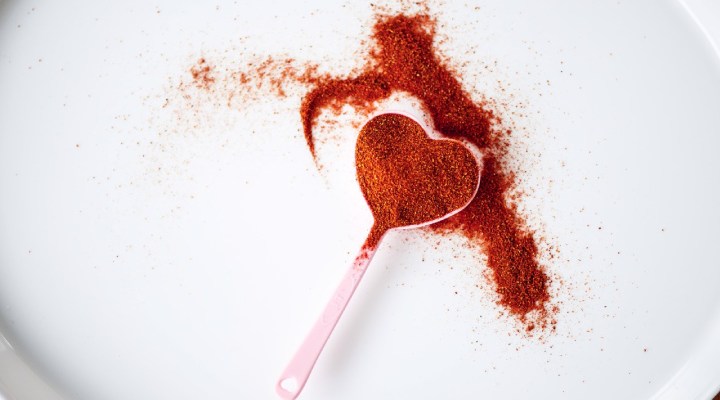Paprika is a colorful, universal spice with many properties
Pepper powders are ground into paprika, which has a sweet, spicy, and sometimes smoky taste. Paprika spices range in color from light orange to dark red. Especially in Hungary, Spain, and Mexico, this delicious spice is in vogue. What are the benefits and properties of paprika and what are its possible side effects? What foods can be prepared with paprika? We’ll answer these questions at the end of the article.

Paprika’s nutrients
Calcium, potassium, and phosphorus in paprika help strengthen teeth, bones, and muscles. A good source of iron and vitamin K, it is also a good source of calcium. A teaspoon of paprika is usually enough for most recipes.
Paprika’s properties
Spiced paprika is a mixture of several types of pepper from the Capsicum annuum family. Red bell peppers, hot chili peppers, cayenne peppers, poblano peppers, and tin peppers may be used as this spice. As a result of the different peppers in this spice, its spiciness is also unique. The majority of people, however, consider paprika to be a sweet spice that is smoked. Eggs and potato salads often contain paprika because of its distinctive color.
It appears that paprika has many health benefits, but these benefits depend on the type of pepper used. Vitamins and minerals such as vitamin A, vitamin E, and vitamin B6 can be found in paprika. Even so, paprika cannot meet all your body’s needs when used as a seasoning.
There are many uses for paprika, including:
Osteoporosis and arthritis treatment;
Boosting the immune system;
Bloating can be reduced;
Anemia prevention;
Hair thickness, softness, and health.
This claim, however, lacks solid scientific evidence.
-
Capsaicin and paprika
It is believed that the capsaicin in paprika is responsible for some of the claimed health benefits of the spice. Pepper is accelerated by capsaicin, a chemical. Capsaicin is not present in all peppers. For example, paprika made from red bell peppers does not contain capsaicin.
A number of laboratory and animal studies have shown that capsaicin supplementation can help treat obesity. According to another study, capsaicin with an antioxidant effect is beneficial in the treatment of non-alcoholic liver diseases. Among the conditions it is said to treat are:
Diabetic hyperglycemia;
Atherogenesis;
Disorders of metabolism;
Diabetes;
Cardiac hypertrophy;
High blood pressure;
Stroke.
Research has been done on capsaicin supplements, not paprika. A little research has been done on the properties of paprika extract, not the spices available in stores. As a result, these benefits cannot also be attributed to paprika spice.
-
Reduce the risk of disease by eating paprika
Plant compounds called carotenoids protect against cancer and eye diseases. Plants with brightly colored leaves, such as paprika, contain carotenoids.
In a small study, paprika consumption increased plasma carotenoid levels in volunteers to an average level after 12 weeks.
-
Maintain bone health with paprika.
Postmenopausal women benefit from the carotenoids in paprika. In a 24-week study, paprika carotenoid extract maintained bone quality in postmenopausal women.
-
Reduce inflammation and pain with paprika
Analgesic properties of capsaicin make it useful for treating pain. Capsaicin is found in some topical painkillers. Additionally, it reduces inflammation and protects the immune system.
-
Weight and paprika
The capsaicin in paprika suppresses appetite and has anti-obesity properties. It improves fat metabolism, especially the oxidation of abdominal fat. Incorporating capsaicin into the diet reduces appetite and calorie intake.
-
Improve cholesterol levels with paprika
Paprika contains capsaicin, which increases good cholesterol (HDL) and lowers bad cholesterol (LDL). This area needs more research, of course.
-
UV protection and paprika.
Sun damage to the skin can be prevented by consuming paprika in the diet.
-
Cancer prevention with paprika
Studies have shown that capsaicin has anti-cancer properties. A variety of cancers can be prevented by adding paprika to your diet.
-
Blood sugar control and paprika
Furthermore, capsaicin reduces insulin sensitivity and affects blood sugar control genes.
-
Maintain blood health with paprika.
Vitamin E and iron are essential for maintaining healthy blood in paprika.
Hemoglobin, which carries oxygen around the body, contains iron, and vitamin E is needed to build its components. Anemia, fatigue, paleness, and shortness of breath are symptoms of nutrient deficiencies.
Depending on your cooking style and taste, you can use three types of paprika:
Sweet or traditional paprika, also known as ordinary or essential paprika. There is a slight spiciness and sweetness to this paprika. Chili peppers from California, Hungary, or South America are usually used to make this spice. In stores, you can find this spice and use it in egg salads or potato salads.
A first-class paprika, Hungarian paprika is sharper and sweeter than Spanish paprika. Hungarian dishes such as goulash use this spice.
Paprika from Spain, also called pimenton or smoked paprika. This spice has a smoky taste because it is dried over fire. This type of paprika is mild to very sharp in sharpness.
Sprinkle paprika on your food to add color, spiciness, and a smoky flavor. Paprika can be used for meat, seafood, nuts, and other snacks.
The paprika should be stored like any other spice. For up to two months, you can store it in the freezer or in a cabinet away from light and heat. The taste and nutrients of ground paprika can be affected by long-term storage for up to 3 years.
Paprika side effects
Paprika is not harmful enough for cooking, but spices may cause an allergic or non-allergic reaction in some individuals. There are reports that people are allergic to paprika, and some call it an allergen.
A distinction must be made between allergic and non-allergic reactions, as the former is life-threatening and the latter usually resolves without treatment. An allergic reaction can cause an itchy mouth or cough from inhalation, and it can also cause difficulty breathing or anaphylactic shock. In case you are allergic to pepper or react after eating foods containing paprika, consult your doctor.
Questions and answers
-
Can you suggest an alternative to paprika?
It depends on how you use it and your taste. You can use red pepper if you’re preparing spicy food, and Chipotle pepper powder if you’re looking for a smoky flavor.
-
Paprika oil: what is it?
Hungarian cuisine uses this fragrant red oil as a condiment or for cooking.


